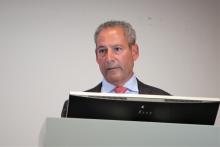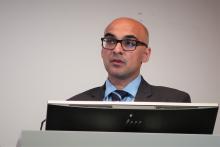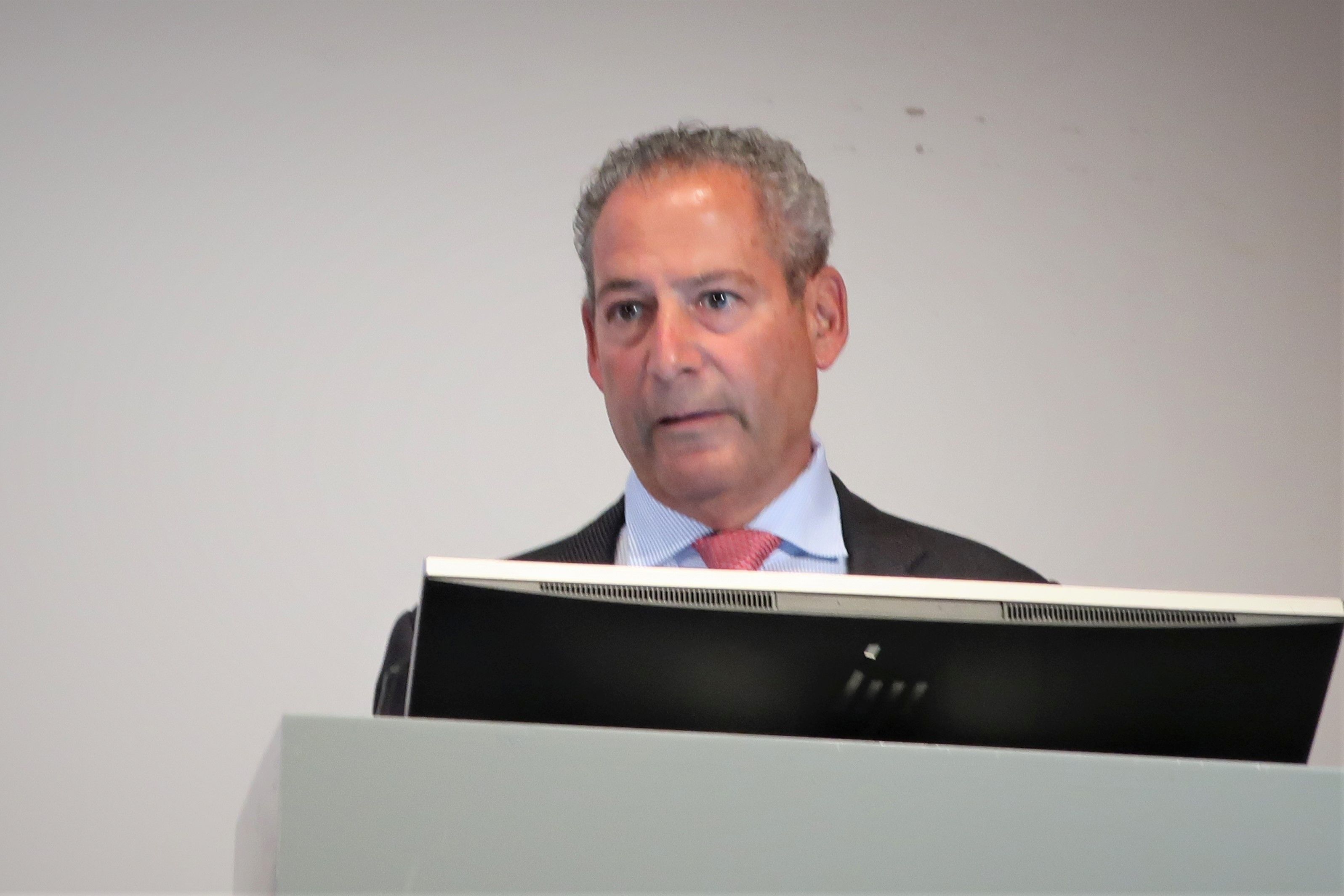User login
BARCELONA – The SGLT2 inhibitor dapagliflozin (Farxiga) became the third agent from the class to show evidence for efficacy in patients with heart failure with preserved ejection fraction (HFpEF) in results from more than 6,200 randomized patients in the DELIVER trial.
These results proved that dapagliflozin treatment benefits patients with heart failure regardless of their left ventricular function, when considered in tandem with previously reported findings in the DAPA-HF trial that tested the same drug in patients with heart failure with reduced ejection fraction (HFrEF). The DELIVER results for dapagliflozin also highlighted an apparent class effect for heart failure from agents from the sodium-glucose cotransporter 2 (SGLT2) inhibitor class, because of similar, prior findings for two other drugs in the class: empagliflozin (Jardiance) and sotagliflozin (approved in Europe and sold under the name Zynquista).
The upshot, said experts, is that the DELIVER results have further solidified a new paradigm for treating patients with heart failure that is much more agnostic when it comes to left ventricular function and underscores the need to quickly start SGLT2 inhibitor treatment in patients as soon as they receive a heart failure diagnosis, without the need to first measure and consider a patient’s left ventricular ejection fraction.
The new data support the use of SGLT2 inhibitors as “foundational agents for virtually all patients with heart failure” regardless of their ejection fraction or whether or not they have type 2 diabetes, said Scott D. Solomon, MD, who presented the primary results from the DELIVER trial at the annual congress of the European Society of Cardiology. Simultaneous publication of the findings occurred online in The New England Journal of Medicine.
A key finding of DELIVER, confirmed in several combined analyses also reported at the congress, was that the benefit of dapagliflozin treatment extended to patients with HFpEF in the highest ranges of ejection fraction, stressed Dr. Solomon, a professor of medicine at Harvard Medical School and Brigham and Women’s Hospital, both in Boston.
Combined analyses document consistency
Combined analysis of the DELIVER results with the findings from DAPA-HF in a prespecified analysis that included a total of 11,007 patients with heart failure across the full spectrum of ejection fraction values (with individual patients having values as low as less than 20% or as high as more than 70%) showed a consistent benefit from dapagliflozin treatment for significantly reducing the combined endpoint of cardiovascular death or hospitalization for heart failure by about 22%, compared with placebo, across the complete range of this ejection fraction continuum.
The consistency of the benefit, regardless of left ventricular function, “is important clinically, as patients often have to wait for a heart scan to measure ejection fraction and decide on which therapies are indicated,” said Pardeep S. Jhund, MBChB, PhD, who reported this analysis in a separate talk at the congress and in a simultaneous publicationonline in Nature Medicine. Provided patients have no contraindications to treatment with dapagliflozin or another evidence-based SGLT2 inhibitor, prescribing this class prior to imaging to assess ejection fraction “speeds access to this life-saving medication,” said Dr. Jhund, a professor of cardiology and epidemiology at the University of Glasgow.
A second, prespecified combined analysis coupled the DELIVER findings with the results of a prior large trial that assessed empagliflozin in patients with HFpEF, EMPEROR-Preserved, which had shown similar findings but with an apparent diminishment of activity in patients at the highest range of preserved left ventricular function, with ejection fractions in excess of about 65%, a tail-off of effect not seen in DELIVER.
In EMPEROR-Preserved alone, patients with ejection fractions of 60% or greater did not show a significant benefit from empagliflozin treatment, although the data showed a numerical trend toward fewer adverse outcome events. When combined with the DELIVER data in a total of 12,251 patients, the subgroup of more than 3,800 patients with an ejection fraction of at least 60% showed a significant 19% relative reduction, compared with placebo in the rate of cardiovascular death or hospitalization for heart failure, reported Muthiah Vaduganathan, MD, in a separate talk at the congress, a finding that confirms the efficacy of SGLT2 inhibitors in this subgroup of patients.
A third combined analysis, also presented by Dr. Vaduganathan, added to these 12,000 patients’ data from DAPA-HF, the empagliflozin trial in patients with HFrEF called EMPEROR-Reduced, and a study of a third SGLT2 inhibitor, sotagliflozin, SOLOIST-WHF, an amalgam of more than 21,000 patients. Again, the results showed cross-trial consistency, and a significant, overall 23% reduction, compared with placebo in the rate of cardiovascular death or hospitalization for heart failure, with a number-needed-to-treat of 25 to prevent one of these events during an average follow-up of 23 months.
“The totality of evidence supports prioritizing the use of SGLT2 inhibitors in all patients with heart failure irrespective of phenotype or care setting,” concluded Dr. Vaduganathan, a cardiologist at Brigham and Women’s Hospital, Boston. Simultaneous with his talk the details of the two combined analyses he presented appeared in The Lancet.
A ‘swan song’ for ejection fraction
“The striking consistency of effect across the entire ejection fraction range” from SGLT2 inhibitors heralds a “swan song for ejection fraction,” commented Frank Ruschitzka, MD, director of the Heart Center of the University Hospital of Zürich and designated discussant for Dr. Vaduganathan’s report. He also predicted that the medical societies that produce recommendations for managing patient with heart failure will soon, based on the accumulated data, give SGLT2 inhibitors a strong recommendation for use on most heart failure patients, sentiments echoed by several other discussants at the meeting and by editorialists who wrote about the newly published studies.
“SGLT2 inhibitors are the bedrock of therapy for heart failure regardless of ejection fraction or care setting,” wrote Katherine R. Tuttle, MD, and Janani Rangaswami, MD, in an editorial that accompanied the combined analysis published by Dr. Vaduganathan.
DELIVER was funded by AstraZeneca, the company that markets dapagliflozin. Dr. Solomon has been a consultant to and received research funding from AstraZeneca and numerous other companies. Dr. Jhund has received research funding from AstraZeneca. Dr. Vaduganathan has been an advisor to and received research funding from AstraZeneca and numerous other companies. Dr. Tuttle has been a consultant to AstraZeneca as well as Bayer, Boehringer Ingelheim, Eli Lilly, Gilead, Goldfinch Bio, Novo Nordisk, and Travere. Dr. Rangaswami has been a consultant to AstraZeneca as well as Boehringer Ingelheim, Edwards, and Eli Lilly, and she has been an advisor to Procyrion.
BARCELONA – The SGLT2 inhibitor dapagliflozin (Farxiga) became the third agent from the class to show evidence for efficacy in patients with heart failure with preserved ejection fraction (HFpEF) in results from more than 6,200 randomized patients in the DELIVER trial.
These results proved that dapagliflozin treatment benefits patients with heart failure regardless of their left ventricular function, when considered in tandem with previously reported findings in the DAPA-HF trial that tested the same drug in patients with heart failure with reduced ejection fraction (HFrEF). The DELIVER results for dapagliflozin also highlighted an apparent class effect for heart failure from agents from the sodium-glucose cotransporter 2 (SGLT2) inhibitor class, because of similar, prior findings for two other drugs in the class: empagliflozin (Jardiance) and sotagliflozin (approved in Europe and sold under the name Zynquista).
The upshot, said experts, is that the DELIVER results have further solidified a new paradigm for treating patients with heart failure that is much more agnostic when it comes to left ventricular function and underscores the need to quickly start SGLT2 inhibitor treatment in patients as soon as they receive a heart failure diagnosis, without the need to first measure and consider a patient’s left ventricular ejection fraction.
The new data support the use of SGLT2 inhibitors as “foundational agents for virtually all patients with heart failure” regardless of their ejection fraction or whether or not they have type 2 diabetes, said Scott D. Solomon, MD, who presented the primary results from the DELIVER trial at the annual congress of the European Society of Cardiology. Simultaneous publication of the findings occurred online in The New England Journal of Medicine.
A key finding of DELIVER, confirmed in several combined analyses also reported at the congress, was that the benefit of dapagliflozin treatment extended to patients with HFpEF in the highest ranges of ejection fraction, stressed Dr. Solomon, a professor of medicine at Harvard Medical School and Brigham and Women’s Hospital, both in Boston.
Combined analyses document consistency
Combined analysis of the DELIVER results with the findings from DAPA-HF in a prespecified analysis that included a total of 11,007 patients with heart failure across the full spectrum of ejection fraction values (with individual patients having values as low as less than 20% or as high as more than 70%) showed a consistent benefit from dapagliflozin treatment for significantly reducing the combined endpoint of cardiovascular death or hospitalization for heart failure by about 22%, compared with placebo, across the complete range of this ejection fraction continuum.
The consistency of the benefit, regardless of left ventricular function, “is important clinically, as patients often have to wait for a heart scan to measure ejection fraction and decide on which therapies are indicated,” said Pardeep S. Jhund, MBChB, PhD, who reported this analysis in a separate talk at the congress and in a simultaneous publicationonline in Nature Medicine. Provided patients have no contraindications to treatment with dapagliflozin or another evidence-based SGLT2 inhibitor, prescribing this class prior to imaging to assess ejection fraction “speeds access to this life-saving medication,” said Dr. Jhund, a professor of cardiology and epidemiology at the University of Glasgow.
A second, prespecified combined analysis coupled the DELIVER findings with the results of a prior large trial that assessed empagliflozin in patients with HFpEF, EMPEROR-Preserved, which had shown similar findings but with an apparent diminishment of activity in patients at the highest range of preserved left ventricular function, with ejection fractions in excess of about 65%, a tail-off of effect not seen in DELIVER.
In EMPEROR-Preserved alone, patients with ejection fractions of 60% or greater did not show a significant benefit from empagliflozin treatment, although the data showed a numerical trend toward fewer adverse outcome events. When combined with the DELIVER data in a total of 12,251 patients, the subgroup of more than 3,800 patients with an ejection fraction of at least 60% showed a significant 19% relative reduction, compared with placebo in the rate of cardiovascular death or hospitalization for heart failure, reported Muthiah Vaduganathan, MD, in a separate talk at the congress, a finding that confirms the efficacy of SGLT2 inhibitors in this subgroup of patients.
A third combined analysis, also presented by Dr. Vaduganathan, added to these 12,000 patients’ data from DAPA-HF, the empagliflozin trial in patients with HFrEF called EMPEROR-Reduced, and a study of a third SGLT2 inhibitor, sotagliflozin, SOLOIST-WHF, an amalgam of more than 21,000 patients. Again, the results showed cross-trial consistency, and a significant, overall 23% reduction, compared with placebo in the rate of cardiovascular death or hospitalization for heart failure, with a number-needed-to-treat of 25 to prevent one of these events during an average follow-up of 23 months.
“The totality of evidence supports prioritizing the use of SGLT2 inhibitors in all patients with heart failure irrespective of phenotype or care setting,” concluded Dr. Vaduganathan, a cardiologist at Brigham and Women’s Hospital, Boston. Simultaneous with his talk the details of the two combined analyses he presented appeared in The Lancet.
A ‘swan song’ for ejection fraction
“The striking consistency of effect across the entire ejection fraction range” from SGLT2 inhibitors heralds a “swan song for ejection fraction,” commented Frank Ruschitzka, MD, director of the Heart Center of the University Hospital of Zürich and designated discussant for Dr. Vaduganathan’s report. He also predicted that the medical societies that produce recommendations for managing patient with heart failure will soon, based on the accumulated data, give SGLT2 inhibitors a strong recommendation for use on most heart failure patients, sentiments echoed by several other discussants at the meeting and by editorialists who wrote about the newly published studies.
“SGLT2 inhibitors are the bedrock of therapy for heart failure regardless of ejection fraction or care setting,” wrote Katherine R. Tuttle, MD, and Janani Rangaswami, MD, in an editorial that accompanied the combined analysis published by Dr. Vaduganathan.
DELIVER was funded by AstraZeneca, the company that markets dapagliflozin. Dr. Solomon has been a consultant to and received research funding from AstraZeneca and numerous other companies. Dr. Jhund has received research funding from AstraZeneca. Dr. Vaduganathan has been an advisor to and received research funding from AstraZeneca and numerous other companies. Dr. Tuttle has been a consultant to AstraZeneca as well as Bayer, Boehringer Ingelheim, Eli Lilly, Gilead, Goldfinch Bio, Novo Nordisk, and Travere. Dr. Rangaswami has been a consultant to AstraZeneca as well as Boehringer Ingelheim, Edwards, and Eli Lilly, and she has been an advisor to Procyrion.
BARCELONA – The SGLT2 inhibitor dapagliflozin (Farxiga) became the third agent from the class to show evidence for efficacy in patients with heart failure with preserved ejection fraction (HFpEF) in results from more than 6,200 randomized patients in the DELIVER trial.
These results proved that dapagliflozin treatment benefits patients with heart failure regardless of their left ventricular function, when considered in tandem with previously reported findings in the DAPA-HF trial that tested the same drug in patients with heart failure with reduced ejection fraction (HFrEF). The DELIVER results for dapagliflozin also highlighted an apparent class effect for heart failure from agents from the sodium-glucose cotransporter 2 (SGLT2) inhibitor class, because of similar, prior findings for two other drugs in the class: empagliflozin (Jardiance) and sotagliflozin (approved in Europe and sold under the name Zynquista).
The upshot, said experts, is that the DELIVER results have further solidified a new paradigm for treating patients with heart failure that is much more agnostic when it comes to left ventricular function and underscores the need to quickly start SGLT2 inhibitor treatment in patients as soon as they receive a heart failure diagnosis, without the need to first measure and consider a patient’s left ventricular ejection fraction.
The new data support the use of SGLT2 inhibitors as “foundational agents for virtually all patients with heart failure” regardless of their ejection fraction or whether or not they have type 2 diabetes, said Scott D. Solomon, MD, who presented the primary results from the DELIVER trial at the annual congress of the European Society of Cardiology. Simultaneous publication of the findings occurred online in The New England Journal of Medicine.
A key finding of DELIVER, confirmed in several combined analyses also reported at the congress, was that the benefit of dapagliflozin treatment extended to patients with HFpEF in the highest ranges of ejection fraction, stressed Dr. Solomon, a professor of medicine at Harvard Medical School and Brigham and Women’s Hospital, both in Boston.
Combined analyses document consistency
Combined analysis of the DELIVER results with the findings from DAPA-HF in a prespecified analysis that included a total of 11,007 patients with heart failure across the full spectrum of ejection fraction values (with individual patients having values as low as less than 20% or as high as more than 70%) showed a consistent benefit from dapagliflozin treatment for significantly reducing the combined endpoint of cardiovascular death or hospitalization for heart failure by about 22%, compared with placebo, across the complete range of this ejection fraction continuum.
The consistency of the benefit, regardless of left ventricular function, “is important clinically, as patients often have to wait for a heart scan to measure ejection fraction and decide on which therapies are indicated,” said Pardeep S. Jhund, MBChB, PhD, who reported this analysis in a separate talk at the congress and in a simultaneous publicationonline in Nature Medicine. Provided patients have no contraindications to treatment with dapagliflozin or another evidence-based SGLT2 inhibitor, prescribing this class prior to imaging to assess ejection fraction “speeds access to this life-saving medication,” said Dr. Jhund, a professor of cardiology and epidemiology at the University of Glasgow.
A second, prespecified combined analysis coupled the DELIVER findings with the results of a prior large trial that assessed empagliflozin in patients with HFpEF, EMPEROR-Preserved, which had shown similar findings but with an apparent diminishment of activity in patients at the highest range of preserved left ventricular function, with ejection fractions in excess of about 65%, a tail-off of effect not seen in DELIVER.
In EMPEROR-Preserved alone, patients with ejection fractions of 60% or greater did not show a significant benefit from empagliflozin treatment, although the data showed a numerical trend toward fewer adverse outcome events. When combined with the DELIVER data in a total of 12,251 patients, the subgroup of more than 3,800 patients with an ejection fraction of at least 60% showed a significant 19% relative reduction, compared with placebo in the rate of cardiovascular death or hospitalization for heart failure, reported Muthiah Vaduganathan, MD, in a separate talk at the congress, a finding that confirms the efficacy of SGLT2 inhibitors in this subgroup of patients.
A third combined analysis, also presented by Dr. Vaduganathan, added to these 12,000 patients’ data from DAPA-HF, the empagliflozin trial in patients with HFrEF called EMPEROR-Reduced, and a study of a third SGLT2 inhibitor, sotagliflozin, SOLOIST-WHF, an amalgam of more than 21,000 patients. Again, the results showed cross-trial consistency, and a significant, overall 23% reduction, compared with placebo in the rate of cardiovascular death or hospitalization for heart failure, with a number-needed-to-treat of 25 to prevent one of these events during an average follow-up of 23 months.
“The totality of evidence supports prioritizing the use of SGLT2 inhibitors in all patients with heart failure irrespective of phenotype or care setting,” concluded Dr. Vaduganathan, a cardiologist at Brigham and Women’s Hospital, Boston. Simultaneous with his talk the details of the two combined analyses he presented appeared in The Lancet.
A ‘swan song’ for ejection fraction
“The striking consistency of effect across the entire ejection fraction range” from SGLT2 inhibitors heralds a “swan song for ejection fraction,” commented Frank Ruschitzka, MD, director of the Heart Center of the University Hospital of Zürich and designated discussant for Dr. Vaduganathan’s report. He also predicted that the medical societies that produce recommendations for managing patient with heart failure will soon, based on the accumulated data, give SGLT2 inhibitors a strong recommendation for use on most heart failure patients, sentiments echoed by several other discussants at the meeting and by editorialists who wrote about the newly published studies.
“SGLT2 inhibitors are the bedrock of therapy for heart failure regardless of ejection fraction or care setting,” wrote Katherine R. Tuttle, MD, and Janani Rangaswami, MD, in an editorial that accompanied the combined analysis published by Dr. Vaduganathan.
DELIVER was funded by AstraZeneca, the company that markets dapagliflozin. Dr. Solomon has been a consultant to and received research funding from AstraZeneca and numerous other companies. Dr. Jhund has received research funding from AstraZeneca. Dr. Vaduganathan has been an advisor to and received research funding from AstraZeneca and numerous other companies. Dr. Tuttle has been a consultant to AstraZeneca as well as Bayer, Boehringer Ingelheim, Eli Lilly, Gilead, Goldfinch Bio, Novo Nordisk, and Travere. Dr. Rangaswami has been a consultant to AstraZeneca as well as Boehringer Ingelheim, Edwards, and Eli Lilly, and she has been an advisor to Procyrion.
AT ESC CONGRESS 2022



